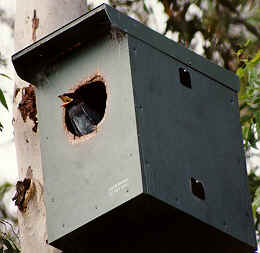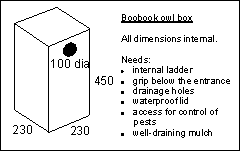Product range:
Batboxes
Pale-headed rosella
Eastern rosella
Cockatiel
Rainbow lorikeet
Scaly-breasted lorikeet
Galah
Kookaburra
Dollar bird
Boobook owl
Brushtail possum
Brushtail vertical
Ringtail possum
Squirrel glider
Sugar glider
| Dollarbird nestbox |
|
|
| Home / Contact us / Product range / Stories / Pest management / Prices |
Dollarbirds are Australia's only migratory hollow-user. They typically breed in hollows at the very tops of tall gum trees. Dollarbirds do take readily to nestboxes, especially if they are located very high in trees. However, putting boxes up very high is not easy to do, and high boxes are even worse to maintain.We have now had six instances of
dollarbirds breeding in nestboxes at our standard height of 5-6m. This is very low
compared with where they normally breed. The photo illustrates one successful attempt, in
this case using a duckbox. |
|
| All
six boxes had one thing in common - a large volume of open space in front of the box, with
no tree trunks or vegetation either side of the box and down to ground level. Doubtless
this emulates the conditions that exist where they normally breed high up in trees. While
these observations are based on a small sample, it does appear that, for dollar birds, the
siting of the box may be more important than the size of the box. |
|
| Dollarbirds
appear to have no particular preference as regards shape of box. They have, for
example, used our Rosella box and a drum-type boobook box, as well as
the duck box.
Nevertheless, the clutch size (three is common) and the size of the chicks indicate that a
large box is probably best for this bird. They also seem to be very prone to lice
problems, and a larger box would be better from this perspective as well. The sketch
adjacent shows the dimensions of the ply version of our Boobook box.
|
|
| Click here for information on prices. | |


